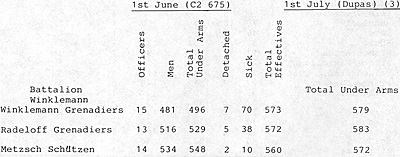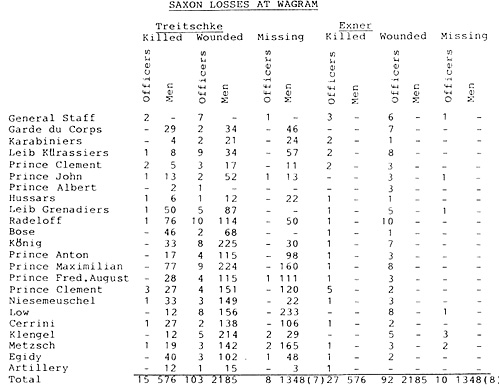
I have been reading Mr. Lochet's two part article on the Saxon behavior at Wagram (see EEL 76 and 77) with great interest, and I would like to make some additional comments as he himself invited in his conclusions.
To establish the strength of the Saxon units I presume Mr.Lochet has referred to the figures given in Armies on the Danube (1) for the returns of IX Corps on 5th July as indeed I previously had (see J. Lochet Note 1). However, on closer examination these figures prove to be identical to those shown in 'Armee d'Allemagne au ler juin 1809' from Carton C2 6'S in the French war archives (2).
With the sole exception of the Prince Clement Infantry Regiment, which is listed as having 893 and not 741 men under arms, all the strengths of the individual units correspond exactly. Also the fact that Armies on the Danube attributes two battalions to certain regiments and gives brigade composition as it was at the outset of the campaign suggests that its order-of-battle relates to a period before the reorganization of IX Corps on 10th June.
The only figures I can find for early July cover the three Saxon battalions that were assigned to the French division of General Dupas, although a comparison between their strength on 1st June and 1st July is helpful in ascertaining an overall estimate for the Saxon Army.

Since the increase in numbers by the time of Wagram is in excess of those available through men returning from detachment and hospital combined, it seems justifiable to assume that the Corps received some reinforcements during June. The only other explanation is that these battalions were allotted troops from the regiments that had their second battalion disbanded, although it is unlikely that this restructuring would have made any more grenadiers or riflemen available. More information concerning Saxon casualties at Wagram exists. Both Hauthal (4) and Schuster (5) give these figures: 590 killed, 2289 wounded and 1356 missing totalling 4238 men inclusive of 126 officers. This summary appears to be derived from the returns of Captain von Treitschke, an officer in the Prince Maximilian Infantry Regiment throughout 1809. They are listed below.
Exner lists the overall casualties for the two days of the battle as follows (6):
- Killed 27 officers and 576 men
Wounded 93 officers and 2185 men
Missing 9 officers and 1348 men (presumed dead)
Total 129 officers and 4109 men
The last two rows differ considerably from those given by Mr. Lochet on page 47 of EEL No. 77. (see Note 2 from J.Lochet)

With regards the number of soldiers killed, wounded and missing this source and Exner are in complete agreement, a rare occurence between two different sources. A discrepancy arises over officer casualties though, and for a couple of reasons I am inclined to accept Exner's total taken from an appendix (this slightly amends his previous figure, and officers wounded and missing become 92 and 10 respectively instead of 93 and 9). Firstly, the register of officer casualties actually lists names, and as most of the differences border between killed or wounded, it seems feasible that some of the officers Treitschke gives as wounded later died of these wounds. Also the two regimental histories 1 have been able to trace, which refer to the Prince Clement Chevaulegers (9) and the Konig Infantry Regiment (10), both match up their figures to Exner.
Therefore, I suggest the following may constitute the Saxon losses at Wagram:
| Result | Officers | Soldiers | Total |
|---|---|---|---|
| Killed | 27 | 576 | 603 |
| Wounded | 92 | 2185 | 2277 |
| Missing | 10 | 1348 | 1358 |
| Total | 4238 | ||
Because of the limited data on unit strengths at Wagram, the only battalions that can be assessed in terms of percentage losses on 5th-6th July are the following two:
| Unit | 1st July | Losses | Percentage |
|---|---|---|---|
| Radeloff Grenadiers | 583 | 251 | 43 |
| Metzsch Schutzen | 572 | 332 | 58 |
NOTES:
(l) S.Bowden and C.Tarbox, Armies on the Danube, 1809, (Arlington, 1980), pp.
149-50.
(2) Carton, C2 675, Vincennes, France.
(3) Dupas report, Situation generale au 1er juillet 1809, quoted in; F.
Duboulez-Dupas and A.Folliet, Le General Dupas (Paris, 1899), pp. 149-50.
(4) F.Hauthal, Geischichte der Sascischen Armee in Wort und Bild (Leipzig, 1859), p.18. He gives the total losses as 4035, but this is a simple arithmetic error.
(5) O.Schurster and F.A. Franke, Geschichte des Sachsischen Armee (Leipzig, 1885), vol.II, p.283.
(6) M.Exner, Die Amtheilnahma der Koniglich Sachsischen Armee am Feldzuge gegen Oesterreich im Jahre 1809, (Dresden, 1894), p.104.
(7) E. von Treitschke, Die Koniglichen Sachsischen Truppen in der Schlacht bei Wagram, am 5. und 6. Juli 1809 in Zeitschrift fur Kunst, Wissenschaft und Geschichte des Krieges (Berlin, 1838), p.139.
(8) Exner,1809, pp. 106-9.
(9) Geschichte des l.Husaren Regiments Konig Albert Nr.18 (Leipzig, 1809), p.184.
(10) Geschichte der beiden Koniglich Sachsischen Grenadiers = Regimenter: Erstes (Leib)-Grenadier---Regiment-Nr.100 (Dresden, 1877,
pp. 143-4.
NOTES FROM J.LOCHET:
(1) The source used in EEL 77 for the strength of the Saxon units is Commandant Saski La Campagne de 1809, which gives the returns from the French official archives in Vincennes. Since Saski is, I believe, the source used in Armies on the Danube, it's not surprising that the figures of Saski and of Armies on the Danube are identical to those of the French Archives Carton C2 675 .
(2) J. Lochet in his EEL 77 article used an English translation of Exner. Apparently a typo or. the translation is the cause of the discrepancy on the last two lines of the Saxon losses.
Back to Empire, Eagles, & Lions Table of Contents Vol. 1 No. 84
Back to EEL List of Issues
Back to MagWeb Master Magazine List
© Copyright 1985 by Emperor's Headquarters
This article appears in MagWeb.com (Magazine Web) on the Internet World Wide Web.
Other articles from military history and related magazines are available at http://www.magweb.com
